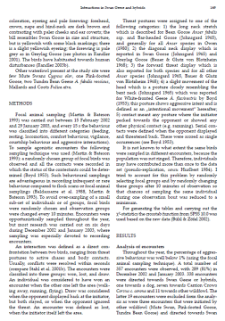- Search in all Repository
- Literature and maps
- Archeology
- Mills database
- Natural sciences
Advanced search
Advanced search
Advanced search
Advanced search
Advanced search

Object
Title: Physiological Condition of Incubating and Brood Rearing Female Great Tits Parus major in Two Contrasting Habitats
Creator:
Kilgas, Priit ; Tilgar, Vallo ; Mägi, Marko ; Mänd, Raivo
Date issued/created:
Resource type:
Subtitle:
Parametry fizjologiczne samic bogatki podczas wysiadywania jaj i wychowu młodych w dwóch środowiskach leśnych ; Habitat differences in physiological condition
Contributor:
Museum and Institute of Zoology, Polish Academy of Sciences
Publisher:
Museum and Institute of Zoology, Polish Academy of Sciences ; Natura Optima Dux Foundation
Place of publishing:
Description:
Type of object:
Abstract:
Little is known about the physiological causes and consequences of habitat choice decisions in birds. We compared size-corrected body mass, hematocrit, plasma albumin, beta- and gamma-globulin and triglyceride concentrations, as well as the albumin/globulin ratio of female Great Tits breeding in deciduous and coniferous forests in Estonia. Females were sampled during incubation and during the chick-rearing period. Whereas the nest box occupation rate and clutch size were higher in the deciduous habitat, the female nutritional condition during incubation was better in the coniferous habitat. This habitat difference in condition was not explained by the differences in the start of egg-laying or clutch size. Females lost more mass from incubation to the chick-rearing stage in the coniferous than in the deciduous forests. Although the values of most blood parameters changed from incubation to the chick-rearing stage, no habitat-related change was observed. There were no habitat differences in the number and quality of fledglings or in female condition during the chick-rearing period. Our results indicate that incubating female Great Tits are in a worse nutritional state in the preferred deciduous habitat fragments than those in the non-preferred coniferous habitat. However, habitat-related differences in condition during incubation seem to be unrelated to habitat-specific reproductive decisions.
Relation:
Volume:
Issue:
Start page:
End page:
Detailed Resource Type:
Format:
Resource Identifier:
oai:rcin.org.pl:55644 ; 10.3161/068.042.0207
Source:
MiIZ PAN, call no. P.257 ; MiIZ PAN, call no. P.4568
Language:
Language of abstract:
Rights:
Terms of use:
Copyright-protected material. May be used within the limits of statutory user freedoms
Digitizing institution:
Museum and Institute of Zoology of the Polish Academy of Sciences
Original in:
Library of the Museum and Institute of Zoology of the Polish Academy of Sciences
Projects co-financed by:
Programme Innovative Economy, 2010-2014, Priority Axis 2. R&D infrastructure ; European Union. European Regional Development Fund
Access:
Object collections:
- Digital Repository of Scientific Institutes > Partners' collections > Museum and Institute of Zoology PAS > Scientific Journals
- Digital Repository of Scientific Institutes > Partners' collections > Museum and Institute of Zoology PAS > MIZ PAN Publications > Acta Ornithologica
- Digital Repository of Scientific Institutes > Literature > Journals/Articles
Last modified:
Feb 4, 2025
In our library since:
Jul 30, 2015
Number of object content downloads / hits:
11
All available object's versions:
https://rcin.org.pl./publication/75722
Show description in RDF format:
Show description in RDFa format:
Show description in OAI-PMH format:
Objects Similar
Tilgar, Vallo (1973– ) Mänd, Raivo (1954– ) Leivits, Agu
Wesołowski, Tomasz (1950– ) Tomiałojć, Ludwik (1939– ) Stawarczyk, Tadeusz (1952– )
Bartkowiak, Stanisław (1900– )
Sánchez, Sara Javier Cuervo, José Moreno, Eulalia
Woon-Kee, Paek Hahm, Kyu-Hwang
An expanded scale for the assessment of fatness in great tits Parus major in the non-breeding period
Nowakowski, Jarosław K. Rowiński, Patryk
Czaja-Topińska, Joanna (1943– )
Nowakowski, Jarosław K. Rowiński, Patryk

 INSTYTUT ARCHEOLOGII I ETNOLOGII POLSKIEJ AKADEMII NAUK
INSTYTUT ARCHEOLOGII I ETNOLOGII POLSKIEJ AKADEMII NAUK
 INSTYTUT BADAŃ LITERACKICH POLSKIEJ AKADEMII NAUK
INSTYTUT BADAŃ LITERACKICH POLSKIEJ AKADEMII NAUK
 INSTYTUT BADAWCZY LEŚNICTWA
INSTYTUT BADAWCZY LEŚNICTWA
 INSTYTUT BIOLOGII DOŚWIADCZALNEJ IM. MARCELEGO NENCKIEGO POLSKIEJ AKADEMII NAUK
INSTYTUT BIOLOGII DOŚWIADCZALNEJ IM. MARCELEGO NENCKIEGO POLSKIEJ AKADEMII NAUK
 INSTYTUT BIOLOGII SSAKÓW POLSKIEJ AKADEMII NAUK
INSTYTUT BIOLOGII SSAKÓW POLSKIEJ AKADEMII NAUK
 INSTYTUT CHEMII FIZYCZNEJ PAN
INSTYTUT CHEMII FIZYCZNEJ PAN
 INSTYTUT CHEMII ORGANICZNEJ PAN
INSTYTUT CHEMII ORGANICZNEJ PAN
 INSTYTUT FILOZOFII I SOCJOLOGII PAN
INSTYTUT FILOZOFII I SOCJOLOGII PAN
 INSTYTUT GEOGRAFII I PRZESTRZENNEGO ZAGOSPODAROWANIA PAN
INSTYTUT GEOGRAFII I PRZESTRZENNEGO ZAGOSPODAROWANIA PAN
 INSTYTUT HISTORII im. TADEUSZA MANTEUFFLA POLSKIEJ AKADEMII NAUK
INSTYTUT HISTORII im. TADEUSZA MANTEUFFLA POLSKIEJ AKADEMII NAUK
 INSTYTUT JĘZYKA POLSKIEGO POLSKIEJ AKADEMII NAUK
INSTYTUT JĘZYKA POLSKIEGO POLSKIEJ AKADEMII NAUK
 INSTYTUT MATEMATYCZNY PAN
INSTYTUT MATEMATYCZNY PAN
 INSTYTUT MEDYCYNY DOŚWIADCZALNEJ I KLINICZNEJ IM.MIROSŁAWA MOSSAKOWSKIEGO POLSKIEJ AKADEMII NAUK
INSTYTUT MEDYCYNY DOŚWIADCZALNEJ I KLINICZNEJ IM.MIROSŁAWA MOSSAKOWSKIEGO POLSKIEJ AKADEMII NAUK
 INSTYTUT PODSTAWOWYCH PROBLEMÓW TECHNIKI PAN
INSTYTUT PODSTAWOWYCH PROBLEMÓW TECHNIKI PAN
 INSTYTUT SLAWISTYKI PAN
INSTYTUT SLAWISTYKI PAN
 SIEĆ BADAWCZA ŁUKASIEWICZ - INSTYTUT TECHNOLOGII MATERIAŁÓW ELEKTRONICZNYCH
SIEĆ BADAWCZA ŁUKASIEWICZ - INSTYTUT TECHNOLOGII MATERIAŁÓW ELEKTRONICZNYCH
 MUZEUM I INSTYTUT ZOOLOGII POLSKIEJ AKADEMII NAUK
MUZEUM I INSTYTUT ZOOLOGII POLSKIEJ AKADEMII NAUK
 INSTYTUT BADAŃ SYSTEMOWYCH PAN
INSTYTUT BADAŃ SYSTEMOWYCH PAN
 INSTYTUT BOTANIKI IM. WŁADYSŁAWA SZAFERA POLSKIEJ AKADEMII NAUK
INSTYTUT BOTANIKI IM. WŁADYSŁAWA SZAFERA POLSKIEJ AKADEMII NAUK




































